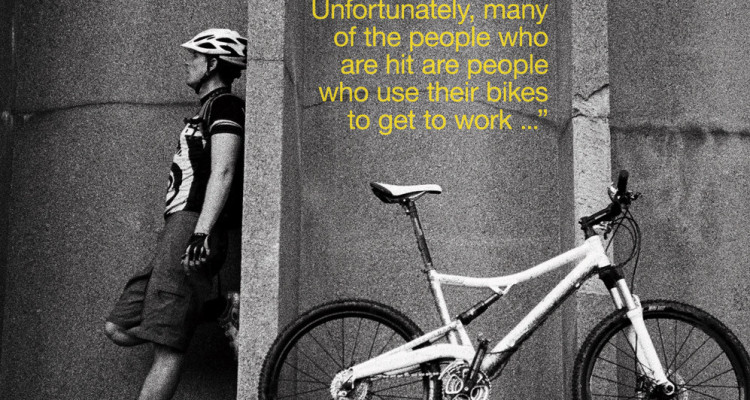Tempers are at an all-time high, here’s what you need to know when cycling
It all started innocently enough. Local photographer and cyclist Erik Kellar was cycling with his usual Tuesday morning group. He’d pulled off to the side of the road to help a fellow rider with a mechanical issue. As the group pulled away, Kellar (whose photos have appeared many times in this magazine) watched a car come dangerously close the departing group. “I mean, it was just inches,” he says.
Kellar finished helping the other cyclist then started back up again. The group they’d drifted back from had stopped at a light a few blocks up. So too was the car that had buzzed the group moments before.
As he pulled up to the pack, Kellar saw a cyclist knocking on the window of the SUV, telling the driver that his pass had been too close. Angry words were exchanged.
The light changed. By this time Kellar had caught up to the main group and could see the argument between the driver and the pack of riders escalating. Rather than getting caught up in it, Kellar rode around the group and continued on his way. “This was not my fight,” he says.
But the fight came to Kellar, anyway. The driver sped away from the stoplight, and slammed into Kellar, cracking Kellar’s pelvis and left orbital—the bone that frames his eye socket. The driver also did thousands of dollars worth of damage to the local photographer’s bike.
Kellar is a fixture in our athletic community, an experienced cyclist and just the latest in a string of high-profile accidents. While these accidents have the local media talking, car-against-bike incidents have been happening in Southwest Florida regularly. Way too regularly.
That’s because Florida is one of the most dangerous states for cyclists in the nation. Between 2008 and 2012, Florida had an average number of 112 cycling fatalities annually. The next closest state, California, had 109 average deaths—and California has three times the cycling population.
And the people getting hit aren’t just of the Lycra-clad variety. “Unfortunately, many of the people who are hit are people who use their bikes to get to work—low income people, and they’re hit, hurt, maimed and not a big deal is made of it,” says Jane Cheffy, the president of Naples Pathways Coalition.
But we at FitNation think it’s time to make a big deal about it. Every life counts and every cyclists matters.
Whether you’ve put on a pair of padded shorts in your life or not, advocating for cyclists is important for the health of our community and for our collective bottom line. A study by the Institute for Tourism and Recreation Research found that in 2012, cycling tourists brought $377 million to the state of Montana. Now imagine the dollars cycling tourists could bring to Florida, which has a much longer riding season.
Also, consider baby boomers: More and more older Americans—many longtime runners with destroyed knees—are entering the sport. They’re looking for places to retire—and they want a place that’s bike friendly. It’s hard to imagine why local officials wouldn’t be falling all over themselves to position Southwest Florida as a cycling-friendly space. Maybe they just need a push in the right direction.
Our local leaders seem to have their hearts in the right place. “Actually, the City of Naples is really, really cooperating with us and they really want to help,” Cheffy says. The local counties are in on it too. Both Collier and Lee have applied “3 Feet, It’s The Law” stickers, which remind drivers that you must pass cyclists with at least three feet of space, to county vehicles.
Still, not everyone has gotten the memo that cyclists have a right to the road. A few weeks ago, a Collier County Sheriff’s deputy stopped Bonita Springs resident Ryan Scofield, who commutes to work on his bike. He had been taking up the entire lane in an area of road where there wasn’t a wide enough shoulder to let a car safely pass. The deputy pulled him over, and Scofield, who rides with a GoPro camera, recorded the whole thing. The officer admonishes Scofield for taking the lane and impeding the flow of traffic. Scofield respectfully disagrees and points out that he’s in what’s called a “substandard lane.” The two go round and round.
There’s been a public debate playing out in the local media about whether or not Scofield was in the right or in the wrong. Fox Four interviewed attorney Ted Zelman, who says that Scofield is in the wrong, due to statute FS 316.2065 (5)(a). This statute says “No person shall drive a motor vehicle at such a slow speed as to impede or block the normal and reasonable movement of traffic, except when reduced speed is necessary for safe operation or in compliance with law.” But bicycles aren’t motor vehicles. Furthermore, Florida has a statute that addresses this exact issue, FS316.2065-5 (a). This statute reads, if a cyclist is in a sub-standard lane (one narrow enough that a car cannot safely pass with at least three feet of space) he or she is not required to ride all the way to the right.
The miscommunication between the police, drivers and cyclists is probably the biggest source of angst, says Becky Afonso, interim executive director of the Florida Bicycle Association. “To make things safer for everybody we really just need more education.”
Kellar couldn’t agree more. “I think every new driver should have to pass the pedestrian and cyclist section of the driving test with a perfect score,” he says. “People just don’t know that we’re allowed to be on the roads.”
And as bad as this year has been for cycling-related injuries in Southwest Florida, there are some bright spots. Aaron Cohen’s Law, which stiffens penalties for hit-and-run drivers, was recently passed. Named for a Miami triathlete killed on an early morning training ride, the law removes the incentive for a drunk driver to leave the scene to sober up in hopes of a lighter sentence. Additionally, in 2013 Florida finally made texting while driving a citable offense—although it’s only a secondary offense, meaning an officer must have another reason to pull you over. “That’s another area we’d like to keep working on,” says Afonso.
Also, most cyclists and cycling advocates hope to see stronger penalties for hitting cyclists. In July, four cyclists were hit by an 84-year-old driver during a regular Saturday morning group ride. One of them was taken to the hospital in critical condition. The driver, meanwhile, walked away with a ticket for careless driving and a ticket for an expired tag. And when a truck driver for Oakes Farms stuck and killed Robin Wallace, of Naples, in 2013, that driver also walked away without any serious charges.
Clearly something needs to be done, but Afonso says it’s not trading in your bike for something safer. “Every day hundreds of miles are ridden without incident,” she says. “People can do this every day.”
Which is true, but it doesn’t mean it’s time to give up the fight. Far from it, in fact. While awful, these recent incidents have brought the issue of cycling safety to the forefront of our community. There’s momentum building, and anyone who has ever ridden a bike knows that it’s what keeps you upright and gets you to your destination. It’s time to shift into a bigger gear and use the momentum we have to get to a better place.

